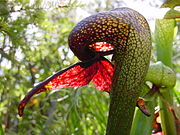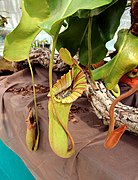User:Sanguinariacanadensis/Pitcher plants
| This is the sandbox page where you will draft your initial Wikipedia contribution.
If you're starting a new article, you can develop it here until it's ready to go live. If you're working on improvements to an existing article, copy only one section at a time of the article to this sandbox to work on, and be sure to use an edit summary linking to the article you copied from. Do not copy over the entire article. You can find additional instructions here. Remember to save your work regularly using the "Publish page" button. (It just means 'save'; it will still be in the sandbox.) You can add bold formatting to your additions to differentiate them from existing content. |
Article Draft
[edit]Types
[edit]The term "pitcher plant" generally refers to members of the Nepenthaceae and Sarraceniaceae families, but similar pitfall traps are employed by the monotypic Cephalotaceae and some members of the Bromeliaceae. The families Nepenthaceae and Sarraceniaceae are the most species-rich families of pitcher plants.
Nepenthaceae
[edit]The Nepenthaceae contains a single genus, Nepenthes, containing over 100 species and numerous hybrids and cultivars.[1] In this genus of Old World pitcher plants, the pitchers are borne at the end of tendrils that extend from the midrib of an otherwise unexceptional leaf. Old World pitcher plants are typically characterized as having reduced and symmetrical pitchers with a comprehensive waxy coating on the surface of the inner pitcher wall.[2] The plants themselves are often climbers, accessing the canopy of their habitats using the aforementioned tendrils, although others are found on the ground in forest clearings, or as epiphytes on trees.
Sarraceniaceae
[edit]The New World pitcher plants (Sarraceniaceae), which comprise three genera,[3] are ground-dwelling herbs whose pitchers arise from a horizontal rhizome. In this family, the entire leaf forms the pitcher, as opposed to Nepenthaceae where the pitcher arises from the terminal portion of the leaf. The species of the genus Heliamphora, which are popularly known as marsh pitchers (or erroneously as sun pitchers), have a simple rolled-leaf pitcher, at the tip of which is a spoon-like structure that secretes nectar. They are restricted to areas of high rainfall in South America. The North American genus Sarracenia are the trumpet pitchers, which have a more complex trap than Heliamphora, with an operculum, which prevents excess accumulation of rainwater in most of the species. The single species in the Californian genus Darlingtonia is popularly known as the cobra plant, due to its possession of an inflated "lid" with elegant false-exits, and a forked "tongue", which serves to ferry ants and other prey to the entrance of the pitcher. The species in the genus Sarracenia readily hybridize, making their classification a complex matter.
The purple pitcher plant, Sarracenia purpurea, is the floral emblem of the province of Newfoundland and Labrador, Canada.
Cephalotaceae
[edit]The Cephalotaceae is a monotypic family with but one genus and species, Cephalotus follicularis. This species has a small (2–5 cm) pitcher similar in form to those of Nepenthes. Unlike in Nepenthes, in Cephalotus follicularis the petiole is attached to the rear of the upper trap rim rather than to the base of the pitcher.[4] The species occurs in only one location in southwestern Australia.
Bromeliaceae
[edit]A few species of bromeliads (Bromeliaceae), such as Brocchinia reducta [5] and Catopsis berteroniana, are known or suspected to be carnivorous. Bromeliads are monocots, and given that they all naturally collect water where their leaves meet each other, and that many collect detritus, it is not surprising that a few should have been naturally selected to develop the habit into carnivory by the addition of wax and downward-pointing hairs.
-
Nepenthes muluensis pitchers hang from tendrils. (This specimen is cultivated.)
-
Most North American pitcher plants belong to the genus Sarracenia.
-
Cobra lilies (Darlingtonia californica) use window-like areolae to lure insects into their hollow leaves.
-
The Australian pitcher plant is the only member of the Australian genus Cephalotus.
Feeding behavior
[edit]Attraction
[edit]Foraging, flying, or crawling insects such as flies are attracted to a cavity formed by the cupped leaf, often by visual lures such as anthocyanin pigments, and nectar.
Capture
[edit]The rim of the pitcher (peristome) is slippery when moistened by condensation or nectar, causing insects to fall into the trap. The walls of the pitfall may be covered with waxy scales, protruding aldehyde crystals, cuticular folds, downward-pointing hairs, or guard-cell-originating lunate cells, to help prevent escape.[6] The small bodies of liquid contained within the pitcher traps are called phytotelmata. They drown the insect, whose body is gradually dissolved. This may occur by bacterial action (the bacteria being washed into the pitcher by rainfall), or by digestive enzymes secreted by the plant itself. Pitcher trap fluids largely vary in their viscoelasticity and acidity which then dictates which type of prey they can target. For example, increased viscoelasticity is associated with increased insect retention to help capture flying insects such as flies, whereas increased fluid acidity can decrease insect killing-time which can help capture crawling insects such as ants.[7] Some pitcher plants contain mutualistic insect larvae, which feed on trapped prey, and whose excreta the plant absorbs.[8]
Digestion
[edit]Whatever the mechanism of digestion, the prey items are converted into a solution of amino acids, peptides, phosphates, ammonium and urea, from which the plant obtains its mineral nutrition (particularly nitrogen and phosphorus). Like all carnivorous plants, they all grow in locations where the soil is too poor in minerals and/or too acidic for most plants to survive. Pitcher plants supplement available nutrients and minerals (which plants normally obtain through their roots) with the constituents of their insect prey.
Mature plants of Nepenthes lowii attract tree shrews (Tupaia montana), which feed on nectar that the plant produces but also defecate into the pitcher, providing nitrates and other nutrients. The plant and tree shrew have a symbiotic relationship. The rim of N. lowii is not slippery so that tree shrews can easily get in and out; it provides more nectar than other pitcher plants. The shape of the pitcher rim and the position of the nectar ensure that the animal's hindquarters are over the rim while it feeds.
Ecology
[edit]Lead
[edit]Article body
[edit]References
[edit]- ^ Moran JA, Clarke CM (2010). "The carnivorous syndrome in Nepenthes pitcher plants: current state of knowledge and potential future directions". Plant Signal Behav. 5 (6): 644–648. doi:10.4161/psb.5.6.11238. PMC 3001552. PMID 21135573.
- ^ Bauer, Ulrike, et al. "Form Follows Function: Morphological Diversification And Alternative Trapping Strategies In Carnivorous Nepenthes Pitcher Plants". Journal of Evolutionary Biology 25.1 (2012): 90–102.
- ^ Lavergne, Sebastien; Ellison, Aaron M.; Butler, Elena D.; Hicks, Emily Jean; Naczi, Robert F. C.; Calie, Patrick J.; Bell, Charles D.; Davis, Charles C. (2012). "Phylogeny and Biogeography of the Carnivorous Plant Family Sarraceniaceae". PLOS ONE. 7 (6): e39291. Bibcode:2012PLoSO...739291E. doi:10.1371/journal.pone.0039291. ISSN 1932-6203. PMC 3374786. PMID 22720090.
- ^ The curious world of carnivorous plants : a comprehensive guide to their biology and cultivation. Wilhelm Barthlott, Michael Ashdown (English language ed ed.). Portland, Or.: Timber Press. 2007. ISBN 978-0-88192-792-4. OCLC 71189676.
{{cite book}}:|edition=has extra text (help)CS1 maint: others (link) - ^ Gonzalez, Jorge M.; Jaffe, Klaus; Michelangeli, Fabian (1991). "Competition for Prey Between the Carnivorous Bromeliaceae Brocchinia reducta and Sarraceneacea Heliamphora nutans". Biotropica. 23 (4): 602–604. doi:10.2307/2388398. ISSN 0006-3606.
- ^ Krol, E.; Plancho, B. J.; Adamec, L.; Stolarz, M.; Dziubinska, H.; Trebacz, Kgv. (2011). "Quite a few reasons for calling carnivores 'the most wonderful plants in the world'". Annals of Botany. 109 (1): 47–64. doi:10.1093/aob/mcr249. PMC 3241575. PMID 21937485.
- ^ Bazile, Vincent; Le Moguédec, Gilles; Marshall, David J.; Gaume, Laurence (2015-03-01). "Fluid physico-chemical properties influence capture and diet in Nepenthes pitcher plants". Annals of Botany. 115 (4): 705–716. doi:10.1093/aob/mcu266. ISSN 0305-7364. PMC 4343297. PMID 25672361.
- ^ McAlpine, D.K. (1998). "Review of the Australian stilt flies (Diptera: Micropezidae) with a phylogenetic analysis of the family". Invertebrate Taxonomy. 12 (1): 55–134. doi:10.1071/IT96018.





